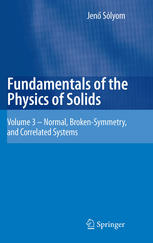

Most ebook files are in PDF format, so you can easily read them using various software such as Foxit Reader or directly on the Google Chrome browser.
Some ebook files are released by publishers in other formats such as .awz, .mobi, .epub, .fb2, etc. You may need to install specific software to read these formats on mobile/PC, such as Calibre.
Please read the tutorial at this link: https://ebookbell.com/faq
We offer FREE conversion to the popular formats you request; however, this may take some time. Therefore, right after payment, please email us, and we will try to provide the service as quickly as possible.
For some exceptional file formats or broken links (if any), please refrain from opening any disputes. Instead, email us first, and we will try to assist within a maximum of 6 hours.
EbookBell Team

4.1
50 reviewsThis book is the third of a three-volume series written by the same author that aims to deliver a comprehensive and self-contained account of the vast field of solid-state physics. It goes far beyond most classic texts in the presentation of the properties of solids and experimentally observed phenomena, along with the basic concepts and theoretical methods used to understand them and the essential features of various experimental techniques.
The first volume deals with the atomic and magnetic structure and dynamics of solids, the second with those electronic properties that can be understood in the one-particle approximation, and the third with the effects due to interactions and correlations between electrons.
In the present volume the electron—electron interaction is treated first in the Hartree—Fock approximation. The density-functional theory is introduced to account for correlation effects. The response to external perturbations is discussed in the framework of linear response theory. Landau’s Fermi-liquid theory is followed by the theory of Luttinger liquids. The subsequent chapters are devoted to electronic phases with broken symmetry: to itinerant magnetism, to spin- and charge-density waves and their realizations in quasi-one-dimensional materials, as well as to the microscopic theory of superconductivity. An overview is given of the physics of strongly correlated systems. The last chapter covers selected problems in the physics of disordered systems.
The text provides material for upper-level undergraduate and graduate courses. It will also be a valuable reference for researchers in the field of condensed matter physics.